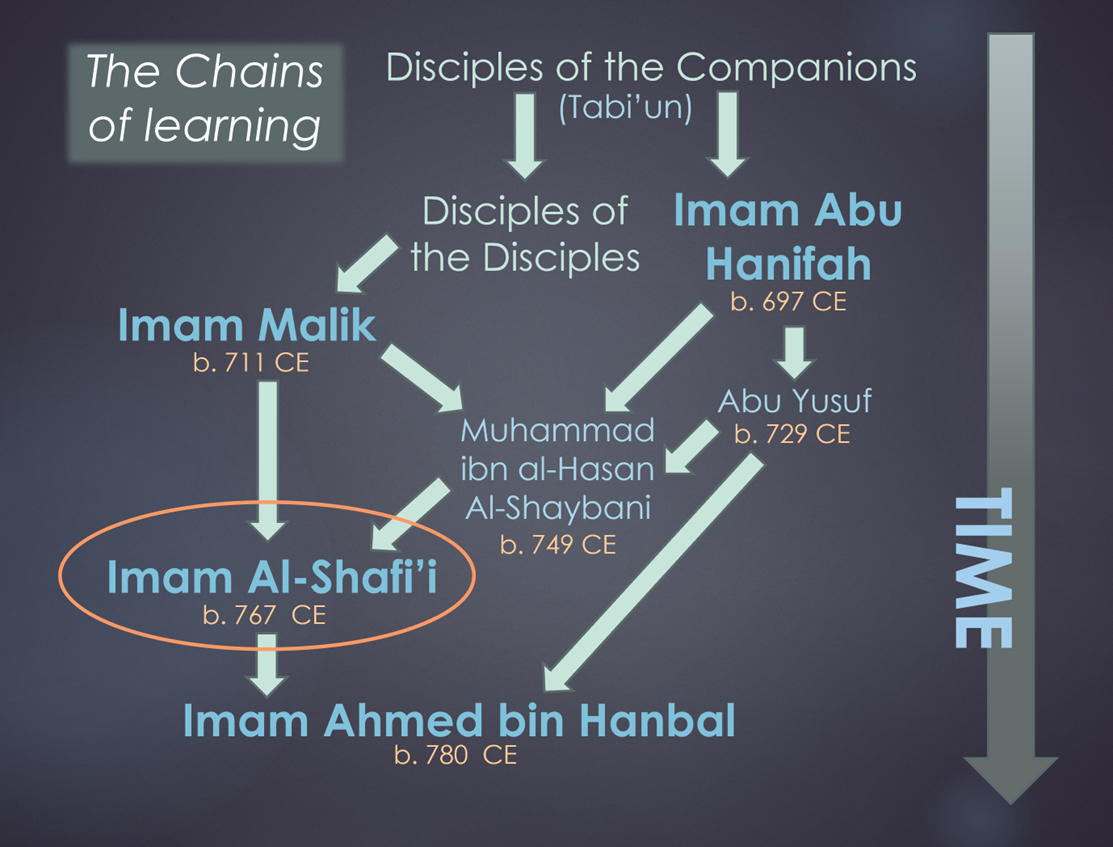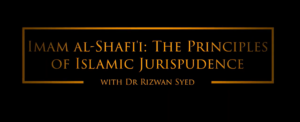Contents
Introduction
This article is best read alongside the article, “Choosing a scholar”.
Prefer lectures to articles? Watch the video of this article & view the timestamps to jump to specific chapters:
Timestamps
7:02
RECAP on Imam Malik & Imam Abu Hanifah
25:04
How different was Imam Shafi’I’s time compared to time of Imams Malik and Abu Hanifah?
Imam Shafi’I’s early years and interest in learning
29:10
What happened when Imam Shafi’I got involved in politics? (29:18)
Imam Shafi’I’s travels as a scholar
Who was Imam Shafi’I’s female teacher and friend?
37:00
What were the principles of Shafi’I jurisprudence?
52:00
How did the Shafi’I madhab deal with new problems?
video chapter (7:02)
1. Recap of previous Imams
Imam Malik
- Held that the Sunnah was based on authentic hadith endorsed by the practice of the learned people of Medina
- Where there were authentic hadith that seemed to oppose each other, Imam Malik accepted those that were endorsed by the practice of Medina, and parked the rest.
- He would also park hadith if they would cause hardship because just as the practice of Medina was the supreme sunnah, so was benefit to the community.
- In the absence of hadith he would go for the opinion of prominent companions from Medina, or their students.
- Or just the accepted practice of the people of Medina because they had been shaped by the Prophet (S).
- Otherwise he would support ruling that conferred benefit to society, known as maslahah
Hanafis
- Saw sunnah as the principles that the Prophet lived by
- Also followed broad principles expressed in the Qur’an
- Or by looking at lots of hadith together
- Only accepted hadith that were mash-hoor (well known) or mutawatir (reinforced by lots of independent authentic chains) for law and beliefs (the rest were parked)
- Or if a teaching was explained by a companion as being the sunnah of the Prophet (S)
- Then they might apply a practicality/ coherence filter – called istihsan
- Isihsan – giving preference to opinions from secondary sources to maintain consistency in the principles
- They also respected the norms of Muslim communities as part of Sunnah (‘the Muslim way’) = ‘Urf (in the way Imam Malik did for just the customs of Medina)
What probably matters most however is the approach to new problems, since that is often when you feel the need to find a scholar anyway:
video chapter (25:04)
2. How different was Imam Shafi’I’s time compared to time of Imams Malik and Abu Hanifah?
Imam Al-Shafi’I (767-820 CE 150-204 AH)
Early years
Imam Shafi’I’s first detailed biography was 250 years after his death. Others have been lost. Some, full of fantastical stories are earlier but not credible.
Imam Shafi’I was born into a Qurayshi family from the same tribe as the Prophet (S) – the Hashimis. In Gaza, Palestine in 150 AH.
He came from a poor family and his father died when he was young. His mother was of Yemeni origin and more of her family were present in Mecca so they moved there.
He had a devotion to learning and due to poverty used to write on shoulder blades. He memorised the Qur’an by the age of 7 and was formally taught by the then Mufti of Mecca. He memorised the Muwatta whilst still in Mecca.
Learning
Later, perhaps about age 20, Imam Shafi’I moved to Medina to devote himself to the famous Imam Malik, for the last 9 years of Malik’s life. He took from Imam Malik all that the teacher could offer.
In later years, though disagreeing with Imam Malik on many issues, he still called him “The Teacher”
video chapter (29:18)
3. What happened when Imam Shafi’I got involved in politics?
Politics
After Imam Malik’s death, at age 30 he was appointed as the Abbasid governor of Yemen, which he administered competently.
However, he got embroiled in the murky world of politics and was accused of plotting with descendants of Ali and brought in chains to Baghdad, to the court of Harun Al Rashid.
Whilst others were sentenced to death, Imam Muhammad ibn Al Hasan defended Al-Shafi’i in addition to Imam Shafi’I himself offering an eloquent defence of his actions, after which he was released.
video chapter (29:10)
4. Imam Shafi’i’s travels as a scholar
As a scholar
He was thus brought into contact with the eminent Imam Muhammad ibn Al Hasan Al Shaybani, under whom he studied for a couple of years.
After his Yemeni experience Imam Shafi’I stayed away from politics and devoted himself to learning and teaching.
Eventually he parted ways with his teacher Al Shaybani, disagreeing with the Hanafi approach, defending the approach of the Malikis, eventually holding an open debate with Al-Shaybani, although still maintaining respect for his Hanafi teacher.
At this point Imam Shafi’I travelled to Mecca, lecturing at the Sacred Mosque. Here he matured his thinking bringing together the strengths of the Malikis and Hanafis but differing with both. One of his devotees in Mecca was Imam Ahmed bin Hanbal.
Finally Imam Shafi’I settled in Egypt, teaching a great many students.
In Egypt he dictated his books and reviewed them with his students.

5. Who was Imam Shafi’I’s female teacher and friend?
Sayyidah Nafisah bint Al-Hasan
He learnt hadith from and attended the lectures of scholar and saintly lady, Sayyidah Nafisah bint Al-Hasan, who had married the son of Imam Ja’far Sadiq – the teacher of both Imam Malik and Imam Abu Hanifah.
She had her own mosque where she would lecture. She was wealthy and generous and financially supported Imam Shafi’I, who would frequently come to her house.
When Imam Al Shafi’i felt sick and afterwards felt the approaching death, he immediately wrote the will in which he mentioned that Nafisa was honourably expected to read the funeral prayer (Janāzah). After death of the Imam, his body was carried to her house and she prayed over it.
video chapter (37:00)
6. What were the principles of Shafi’I jurisprudence?
Imam Al-Shāfi’ī wrote a book called Risala which laid out his Principles of Jurisprudence disagreeing with some of the prevalent approaches.
Here are the key points he provides strong arguments for:
- Accepting Qur’an as the first source
- But that individual hadith instead of just providing specific exceptions to Qur’anic teachings, if they differ, and it is clear the hadith came later, then it abrogates (over-writes) the Qur’anic rule
- And to use the Qur’an as law we need hadith to clarify its meaning
- To do away with all other definitions of sunnah – sunnah is only:
- what was said,
- observed or
- authorised by the Prophet (S)
- Solitary hadith are acceptable for sunnah – giving examples of when the Prophet (S) dispatched companions to places with a message, people did not ask for more messengers to substantiate the message. E.g. the message to stop drinking alcohol.
- Against the Hanafi’s excessive use of reason
- g. istihsan
- or being too liberal in using analogy
Imam Al-Shāfi’ī is credited with creating the essentials of the science of fiqh (the system of Islamic jurisprudence).
He designated the four principles/sources/components of fiqh, which in order of importance are:
- The Qur’an
- Authentic Hadith – having an equal footing to the Qur’an
- i.e. the consensus of the (orthodox) Muslim community
- i.e. the method of analogy
Scholar John Burton: “Where his contemporaries and their predecessors had engaged in defining Islam as a social and historical phenomenon, Shafi’i sought to define a revealed Law.”
Burton, Islamic Theories of Abrogation, 1990: p.14
Al-Shāfi‘ī “insists time after time that nothing can override the authority of the Prophet, even if it be attested only by an isolate tradition, and that every well-authenticated tradition going back to the Prophet has precedence over the opinions of his Companions, their Successors, and later authorities.”
Schacht, Joseph (1959) [1950]. The Origins of Muhammadan Jurisprudence. Oxford University Press. p. 11.
video chapter (52:00)
7. How did the Shafi’I madhab deal with new problems?
If new problems occurred, Imam Malik would have considered any laws that help the public part of shari’ah (maslahah mursalah).
The Hanafis established principles that would embrace new situations, so that Islamic teachings could extend into new contexts, even if the Prophet (S) had not specifically ruled on those situations.
Imam Shafi’is position was that they were dealt with by the authorities and people would have to follow the law, but considered such things outside the scope of Shari’ah. So to not follow the law of the land will get into trouble with the authorities but may not be a spiritual sin as such.

